Biodiversity is a complex term with a range of definitions and contestations and a powerful reach across environmental work, legislation, and popular culture (Callaway, 2020). Understandings of the concept include the variety of different species in an ecosystem, the nature and intensity of their interactions, and the roles each species plays. These understandings are complex because biodiversity is complex (a fuller guide and definition can be found in our introduction blog here). However, across these definitions a key takeaway is biodiversity’s central importance to the health of both ourselves and the environment (Perrings, 2014; Bonneuil and Fressoz, 2016). Due to this, preserving biodiversity is crucial to supporting ourselves and the natural world and a recent approach to achieving this is biodiversity net gain.

What is Biodiversity Net Gain?
Biodiversity Net Gain (BNG) is a policy approach that was adopted by the government in 2021 and came into force in February this year. Unlike previous legislation, this approach stipulates that development projects must create an increase or improvement of biodiversity, rather than just preventing a loss. Therefore, if executed well, this legally-binding process could lead to an ever-expanding spread of biodiversity across our cities. There’s plenty of work involved in achieving these improvements in a meaningful way, however (Bull and Brownlie, 2017).
Following BNG, the first step for any development project is to establish a record, or baseline, of how many biodiverse habitats there are on the relevant site(s). This method, focussing on habitats, is just one approach to baselining and we’re working to gather this data alongside other baselining efforts we’re making to meet the University’s Nature Positive Pledge. There are Lots of things to consider when measuring this data as, when it comes to biodiversity, human impacts and ecosystem complexity make it hard to measure everything (Allard et al., 2023). Consequently, to get as informed an idea as possible of the ecosystems on our estates, we’re focussing not only on the presence of habitats, but also on factors including the campus’s physical context in the city and the types of species that need extra support in our urban environment.
Collaborations with institutions including the City Council, Northumbria University, North East Ambulance service, and the Newcastle NHS Trust have proven important in this process. An example of the power of these partnerships is the Newcastle Biodiversity Group (of which all the above are part), which has helped to join up biodiversity efforts including mapping species migration and habitat corridors across the city. This work has led to the planning of a series of green infrastructure opportunity areas and biodiversity enhancement corridors across the city – and our campus is part of both.
This work is important as, when we then look to improve our estate and add new facilities, such as our cutting-edge Stephenson Building refurb or the sector-leading Health Innovation Neighbourhood, we have an informed view of how best to deliver BNG on these developments. Drawing on expertise from across the region, we can link our efforts to work such as the Newcastle and north Tyneside Biodiversity Action Plan, and, through this, ensure the maximum possible gain in habitat quality, while meeting the legislative requirements of BNG.

A huge thank you to my colleague Charlotte for her help with this blog and all the amazing work she does on biodiversity. While we don’t yet have any case-studies of BNG being implemented on campus, we’re always working hard to help improve biodiversity on our estates. You can read about the special care taken to preserve trees as part of our recent Stephenson Building refurbishment here, or learn more about our biodiversity work on our website and our other blog posts.
References
Allard, A., Carina, H., Keskital, E., and Brown, A. (2023) Monitoring Biodiversity: Combining Environmental and Social Data. Taylor and Francis International Publishing.
Bonneuil, C., Fressoz, J-B. (2016) The Shock of the Anthropocene: The Earth, History and Us. Fernbach, D. (translator). 1st edition. New York, N.Y.: Verso Books.
Bull, J.W., and Brownlie, S. (2017) ‘The transition from No Net Loss to a Net Gain of biodiversity is far from trivial’, Oryx. 51 (1). pp. 53–59.
Callaway, E. (2020). Eden’s Endemics: Narratives of Biodiversity on Earth and Beyond. Charlottesville, V.A.: University of Virginia Press.
Perrings, C. (2014) Our Uncommon Heritage: Biodiversity Change, Ecosystem Services, and Human Wellbeing. Cambridge: Cambridge University Press.
